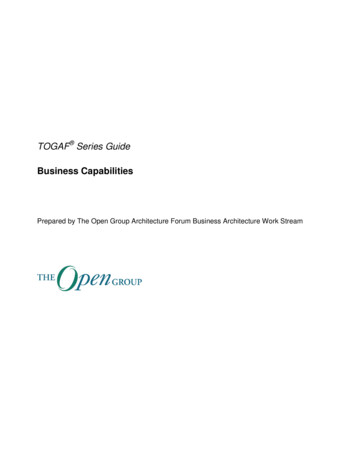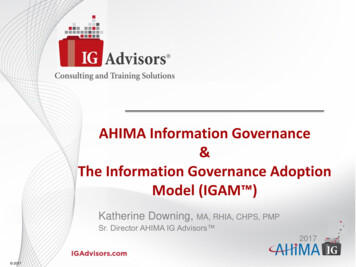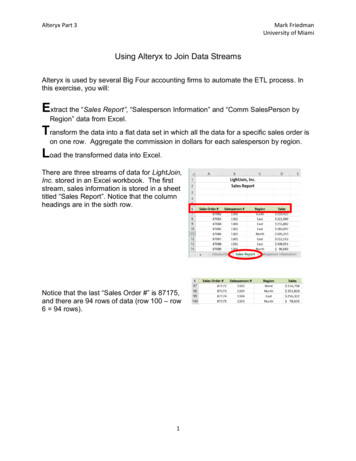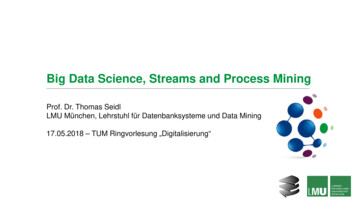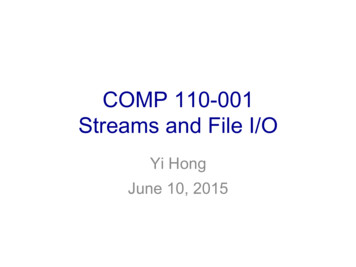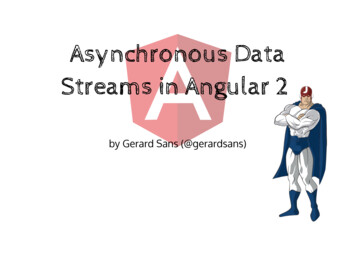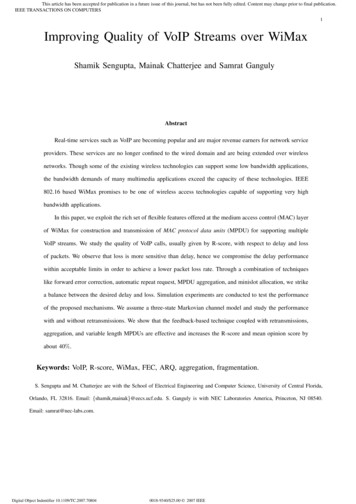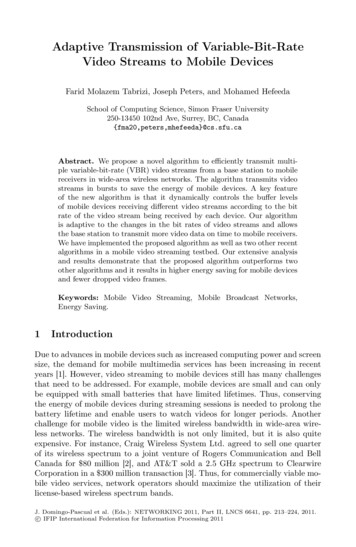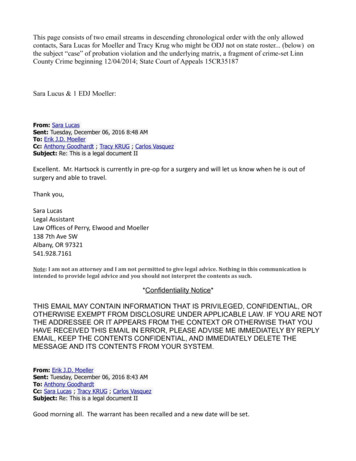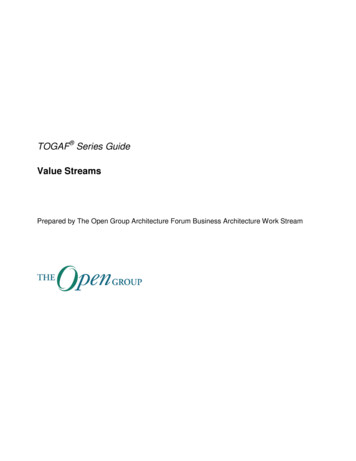
Transcription
TOGAF Series GuideValue StreamsPrepared by The Open Group Architecture Forum Business Architecture Work Stream
Copyright 2017, The Open Group. All rights reserved.No part of this publication may be reproduced, stored in a retrieval system, or transmitted, in any form or by any means,electronic, mechanical, photocopying, recording, or otherwise, without the prior permission of the copyright owner.This Guide has not been verified for avoidance of possible third-party proprietary rights. In implementing this Guide,usual procedures to ensure the respect of possible third-party intellectual property rights should be followed.TOGAF Series GuideValue StreamsISBN:1-947754-02-7Document Number:G178Published by The Open Group, October 2017.Updated in June 2018 to reference the TOGAF Standard, Version 9.2 and the TOGAF Series Guide: BusinessCapabilities (G189).Comments relating to the material contained in this document may be submitted to:The Open Group, Apex Plaza, Forbury Road, Reading, Berkshire, RG1 1AX, United Kingdomor by electronic mail to:ogspecs@opengroup.orgiiTOGAF Series Guide (2017)
ContentsValue Streams1Introduction . 11.1 What is “Value”? . 11.2 Approaches to Value Analysis . 11.3 Value Streams in Business Architecture . 21.4 Relationship of Value Streams to Other Business ArchitectureConcepts . 21.5 Benefits of Value Streams and Value Stream Mapping . 32Value Stream Description, Decomposition, and Mapping . 52.1 Describing a Value Stream . 52.2 Decomposing a Value Stream. 52.3 Mapping Capabilities to Value Stream Stages. 63Approach to Creating Value Streams . 73.1 Guiding Principles . 74Value Stream Mapping Scenarios . 84.1 Baseline Example . 84.2 Mapping Value Streams to Business Capabilities . 94.3 Heat Mapping Scenario . 125Conclusion . 14AComparison of Alternative Value Analysis Techniques . 15A.1 Value Chain . 15A.2 Value Network . 16A.3 Lean Value Stream. 16iii
PrefaceThe Open GroupThe Open Group is a global consortium that enables the achievement of business objectivesthrough technology standards. Our diverse membership of more than 600 organizations includescustomers, systems and solutions suppliers, tools vendors, integrators, academics, andconsultants across multiple industries.The Open Group aims to: Capture, understand, and address current and emerging requirements, establish policies,and share best practices Facilitate interoperability, develop consensus, and evolve and integrate specifications andopen source technologies Operate the industry’s premier certification serviceFurther information on The Open Group is available at www.opengroup.org.The Open Group publishes a wide range of technical documentation, most of which is focusedon development of Open Group Standards and Guides, but which also includes white papers,technical studies, certification and testing documentation, and business titles. Full details and acatalog are available at www.opengroup.org/library. The TOGAF Standard, a Standard of The Open GroupThe TOGAF standard is a proven enterprise methodology and framework used by the world’sleading organizations to improve business efficiency.This DocumentThis document is a TOGAF Series Guide to Value Streams, addressing how to identify, define,model, and map a value stream to other key components of an enterprise’s BusinessArchitecture. It has been developed and approved by The Open Group.This Guide is structured as follows:iv Chapter 1 (Introduction) introduces the concept of value, how it relates to business ingeneral, and how it can be used and applied within Business and Enterprise Architecture Chapter 2 (Value Stream Description, Decomposition, and Mapping) describes thestructure and mechanics of the value stream, including its decomposition into value streamstages Chapter 3 (Approach to Creating Value Streams) sets out guiding principles forconstructing a value stream mapTOGAF Series Guide (2017)
Chapter 4 (Value Stream Mapping Scenarios) describes a range of business scenarios andpractical examples of value stream mapping Chapter 5 (Conclusion) summarizes the role and value that value streams and value streammapping can bring to business Appendix A (Comparison of Alternative Value Analysis Techniques) compares andcontrasts other common value analysis techniques used in business, including the valuechain, value network, and the Lean value streamThe intended audience for this Guide is as follows: Enterprise Architects Business Architects Process modelers Strategy planners About the TOGAF Series GuidesThe TOGAF Series Guides contain guidance on how to use the TOGAF framework. They formpart of the TOGAF Body of Knowledge.The TOGAF Series Guides are expected to be the most rapidly developing part of the TOGAFdocument set. While the TOGAF framework is expected to be long-lived and stable, guidance onthe use of the TOGAF framework can be industry, architectural style, purpose, and problemspecific. For example, the stakeholders, concerns, views, and supporting models required tosupport the transformation of an extended enterprise may be significantly different than thoseused to support the transition of an in-house IT environment to the cloud; both will use theArchitecture Development Method (ADM), start with an Architecture Vision, and develop aTarget Architecture on the way to an Implementation and Migration Plan. The TOGAFframework remains the essential scaffolding across industry, domain, and style.Value Streamsv
TrademarksArchiMate , DirecNet , Making Standards Work , OpenPegasus , Platform 3.0 , The OpenGroup , TOGAF , UNIX , UNIXWARE , and the Open Brand X logo are registeredtrademarks and Boundaryless Information Flow , Build with Integrity Buy with Confidence ,Dependability Through Assuredness , Digital Practitioner Body of Knowledge , DPBoK ,EMMM , FACE , the FACE logo, IT4IT , the IT4IT logo, O-DEF , O-PAS , OpenFAIR , Open O logo, Open Platform 3.0 , Open Process Automation , Open TrustedTechnology Provider , SOSA , and The Open Group Certification logo (Open O andcheck ) are trademarks of The Open Group.All other brands, company, and product names are used for identification purposes only and maybe trademarks that are the sole property of their respective owners.viTOGAF Series Guide (2017)
About the AuthorsThis Open Group Guide was developed by the Business Architecture Work Stream of theArchitecture Forum, a forum of The Open Group.Alec Blair – Program Lead, Enterprise Architecture, Alberta Health ServicesAlec has been working as an Enterprise Architect and Enterprise Architecture manager/coach forthe last 15 of his 28 years in the IT industry. Alec currently leads the Alberta Health ServicesEnterprise Architecture community of expertise and is a Certified Business Architect (CBA ).This virtual team spans more than 40 practitioners working on all dimensions of EnterpriseArchitecture.J. Bryan Lail – RaytheonJ. Bryan Lail is a Business Architect Fellow at Raytheon. He is a Certified Business Architect(CBA ) with the Business Architecture Guild, a Master Certified Architect with The OpenGroup, and a Raytheon Certified Architect applying strategic business architecture methods inthe defense industry. His career has spanned physics research, engineering for the Navy andRaytheon, and multiple publications in the application of architecture to business strategy.Stephen Marshall – Strategy Consultant, IBMStephen Marshall is a Master Certified Architect with The Open Group, a Certified BusinessArchitect (CBA ), and a Senior Management Consultant with the IBM Institute for BusinessValue (IBV). He currently leads the IBV Global C-suite Study program in Asia-Pacific, coauthoring several pieces of thought leadership.Value Streamsvii
AcknowledgementsThe Open Group gratefully acknowledges the contribution of the following people in thedevelopment of this Open Group Guide:viii Chris Armstrong – Armstrong Process Group Mats Gejnevail – Combitech Sonia Gonzalez – The Open Group Harry Hendrickx – Hewlett Packard Enterprise Andrew Josey – The Open Group Gerard Peters – Capgemini Sarina Viljoen – HuaweiTOGAF Series Guide (2017)
Referenced DocumentsThe following documents are referenced in this TOGAF Series Guide. Competitive Advantage: Creating and Sustaining Superior Performance, Michael E.Porter, Free Press, 1985 The Future of Knowledge: Increasing Prosperity through Value Networks, Verna Allee,Butterworth-Heinemann, 2003 The Great Transition: Using the Seven Disciplines of Enterprise Engineering to AlignPeople, Technology, and Strategy, James Martin, American Management Association,1995 The Machine that Changed the World, James Womack, Daniel Jones, and Daniel Roos,Free Press, 1990 TOGAF Series Guide: Business Capabilities (G189), June 2018, published by The OpenGroup: refer to: www.opengroup.org/library/g189The following documents provide useful background information for this Open Group Guide:Value Streams A Guide to Business Architecture Body of Knowledge (BIZBOK Guide), BusinessArchitecture Guild; refer to: www.businessarchitectureguild.org/page/About Open Business Architecture (O-BA) – Part I, an Open Group Preliminary Standard(P161), July 2016, published by The Open Group; available at:www.opengroup.org/library/p161 The TOGAF Standard, Version 9.2, a standard of The Open Group (C182), published byThe Open Group, April 2018; refer to: www.opengroup.org/library/c182ix
xTOGAF Series Guide (2017)
1Introduction1.1What is “Value”?The word “value” originates from the Old French valoir: ‘be worth’. It is the regard thatsomething is held to deserve; the importance, worth, or usefulness of something. Within thecontext of Business Architecture, it is important to think of value in the most general sense ofusefulness, advantage, benefit, or desirability, rather than the relatively narrow accounting orfinancial perspective that defines value as being the material or monetary worth of something.Non-monetary examples of value in the business world include such things as the successfuldelivery of a requested product or service, resolving a client’s problem in a timely manner, orgaining access to up-to-date information in order to make better business decisions.Value is fundamental to everything that an organization does. The primary reason that anorganization exists is to provide value to one or more stakeholders. It is the foundation of afirm’s business model, which describes the rationale for how a business creates, delivers, andcaptures value. The Business or Enterprise Architect should be able to model, measure, andanalyze the various ways that the enterprise achieves value for a given stakeholder. This includesthe ability to decompose the creation, capture, and delivery of value into discrete stages of valueproducing activities, each of which is enabled by the effective application of businesscapabilities (see the TOGAF Series Guide to Business Capabilities). This Guide provides anapproach and examples for modeling business value.1.2Approaches to Value AnalysisSeveral approaches have been used in the past to model, measure, and analyze business value.Three well-known (but often misunderstood) techniques include value chains, value networks,and lean value streams. Each approach has a distinct purpose and area of focus that positions itdifferently from the others – as well as from the value stream that is used within the context ofBusiness Architecture, and which is the subject of this Guide. The value chain takes an economicvalue perspective; value networks are primarily concerned with identifying the participantsinvolved in creating and delivering value; while lean value streams are all about optimizingbusiness processes (primarily within a manufacturing context). Only the Business Architecturevalue stream is designed to create an end-to-end perspective of value from the customer’s (orstakeholder’s) perspective, and in doing so is more closely aligned to realizing an organization’sbusiness model rather than the financial, organizational, or operational models that the otherexamples cater to.Values chains, value networks, and lean value streams are explained and compared in detail inAppendix A.Value Streams1
1.3Value Streams in Business ArchitectureThe approach to value analysis that is used in Business Architecture is derived from JamesMartin’s The Great Transition.1 The value stream (a simple example of which is shown inFigure 1) is depicted as an end-to-end collection of value-adding activities that create an overallresult for a customer, stakeholder, or end-user. In modeling terms, those value-adding activitiesare represented by value stream stages, each of which creates and adds incremental stakeholdervalue from one stage to the next.Acquire Retail lectionProcessPaymentDeliverMerchandiseFigure 1: Example of a Value StreamValue streams may be externally triggered, such as a retail customer acquiring somemerchandise, as shown in the example above. Value streams may also be internally triggered,such as a manager obtaining a new hire. Value streams may be defined at an enterprise level orat a business unit level. Either way, the complete set of value streams (as depicted in a valuestream diagram or map) is simply the visual representation of all the value streams that denote anorganization’s primary set of business activities. It is an aggregation of the multiple ways inwhich the enterprise creates value for its various stakeholders.A key principle of value streams is that value is always defined from the perspective of thestakeholder – the customer, end-user, or recipient of the product, service, or deliverableproduced by the work. The value obtained is in the eye of the beholder; it depends more on thestakeholder’s perception of the worth of the product, service, outcome, or deliverable than on itsintrinsic value; i.e., the cost to produce.1.4Relationship of Value Streams to Other Business ArchitectureConceptsAs part of the practice of Business Architecture, we separate the concern of what we do(business capability), from who does it (organization), from how value is achieved (valuestream), from how it is implemented or performed at an operational level (process), from theinformation that is needed, from the systems that are used, and so on. Figure 2 shows therelationships between value, value streams, and value stream stages (discussed further in thenext section), and other foundational Business Architecture concepts.1See the referenced The Great Transition: Using the Seven Disciplines of Enterprise Engineering to Align People, Technology, andStrategy, by James Martin.2TOGAF Series Guide (2017)
blesparticipates inValue Stageconsists oftriggersValue StreamStakeholdercreatesreceivesValueFigure 2: Value Stream Modeling RelationshipsThe complete set of value streams depicts the various ways in which an organization orchestratesits capabilities to create stakeholder value. The value stream has a direct linkage to anorganization’s business model (specifically to the value proposition). As an organizationtranslates its business model to an operating model, those value stream stages can be translatedinto business processes. Importantly, this translation (or mapping) is not a direct one-to-onetype; a single value stream stage can map to one or more business processes. The process ofmapping value stream stages to business processes is a reflection of operating model-leveldecisions about how to segregate a business model into the various different ways that anorganization can structure itself.Another way to think about the relationship between value streams and business processes is toconsider their viewpoint: value streams take an outside-in perspective – usually a customer orend-user – and show how value gets created and moved around in relation to that stakeholderonly. Business processes, on the other hand, tend to have more of an inward-looking,operational-level focus that is primarily concerned with how work gets done – the operationalimplementation. While some business processes may cover the same stream of activity thatforms a value stream, it usually occurs at a much more granular level. That granularity is idealfor optimizing workflow and efficiency (i.e., incrementally improving existing activities), but itis far less suited to answering deeper questions about how a business should serve its customersin such a way that maximizes the value generated along the way.1.5Benefits of Value Streams and Value Stream MappingMapping value streams (typically performed as part of a broader Business Architectureinitiative) is a quick and easy way to obtain a snapshot of the entire business, since those valuestreams represent all the work that the business needs to perform – at least from a value-deliveryperspective. Doing so helps business leaders assess their organization’s effectiveness at creating,capturing, and delivering value for different stakeholders.Value Streams3
Other benefits of value streams and value stream mapping include:4 Value streams help business leaders envision and prioritize the impact of strategic plans,manage internal and external stakeholder engagement, and deploy new business solutions Viewing business capabilities through the lens of a value stream provides a value-based,customer-centric context for business analysis and planning Value streams provide a framework for more effective business requirements analysis,case management, and solution design By focusing on how business value is achieved and for whom, a fully articulated valuestream map can lead to more effective business and operating models that would nototherwise be identified using an inside-out or bottom-up design approachTOGAF Series Guide (2017)
2Value Stream Description, Decomposition, and MappingThis chapter describes the composition and structure of value streams, and the mechanicsinvolved with breaking them down into value stream stages. It also explores the tight connectionbetween value streams and business capabilities. Mapping value stream stages to their respectiveenabling business capabilities provides a much richer level of understanding about what abusiness should be focusing on (beyond the individual business capability map/model or valuestream diagram).2.1Describing a Value StreamWhile they are most commonly represented in diagrammatic form, value streams are definedusing four standard elements:1.Name – The value stream name must be clearly understandable from the initiatingstakeholder’s perspective. In contrast to the way that business capabilities are named,value streams use an active rather than passive tense. That usually means a verb-nounconstruct. For example, the two value streams that we use throughout this Guide are“Acquire Retail Product” and “Recruit Employee”.2.Description – While the value stream name should be self-explanatory, a short, precisedescription can provide additional clarity on the scope of activities that the value streamdeals with.3.Stakeholder – The person or role that initiates or triggers the value stream.4.Value – The value (expressed in stakeholder terms) that the stakeholder expects to receiveupon successful completion of the value stream. That value is an aggregation of theincremental value items that are delivered by each value stream stage.Continuing with our earlier example:2.2NameAcquire Retail ProductDescriptionThe activities involved in looking for, selecting, and obtaining a desired retail product.StakeholderA retail shopper wishing to purchase a product.ValueCustomers are able to locate desired products and obtain them in a timely manner.Decomposing a Value StreamStakeholder value is rarely produced as the result of a single step or activity. More often, value isachieved through a series of sequential and/or parallel actions, or value stream stages, thatincrementally create and add stakeholder value from one stage to the next.Value Streams5
Each value stream stage comprises the following elements:1.Name – Two to three words identifying what is (or will be) achieved by this stage.2.Description – A few sentences explaining the purpose and the activities performed duringthe value stream stage.3.Stakeholders – Actors who receive measurable value from the value stream stage, or whocontribute to creating or delivering that value.4.Entrance Criteria – The starting condition or state change that either triggers the valuestream stage or enables it to be activated.5.Exit Criteria – The end state condition that denotes the completion of the value streamstage; i.e., when the required value has been created or delivered to the stakeholders. Thisinformation becomes the entry criteria for the next value stream stage.6.Value Item – The incremental value that is created or delivered to the participatingstakeholder(s) by the value stream stage.A value stream does not necessarily flow continuously and uninterrupted from initiation throughto conclusion. Following each value stream stage, there is an opportunity to stop the valuestream if the desired value has not been created or delivered. This could be at the request of theparticipating stakeholder. For example, the Acquire Retail Product value stream may stopbecause the customer decides that they no longer want to purchase the merchandise after theysee the price.2.3Mapping Capabilities to Value Stream StagesHaving defined the end-to-end value stream, the next step is to identify which businesscapabilities are required to enable each value stream stage. This is done by reviewing thebusiness capability map, and linking (i.e., cross-mapping) the relevant business capabilities toeach value stream stage (see the value stream to business capabilities mapping example inSection 4.2).The purpose of this activity is to identify which business capabilities (out of the total set ofcapabilities) are critical to delivering stakeholder value, and therefore which ones need to beperformed to a sufficient standard of quality to meet stakeholder expectations. It also helps toidentify those business capabilities that do not contribute toward any of the core value streams,and which may be eliminated from the business.6TOGAF Series Guide (2017)
3Approach to Creating Value StreamsA common question that confronts many Business Architects is which should come first:developing the value stream map or the business capability model? The short answer is that itdoes not matter, because one should not exist without the other for very long. Value streamsprovide valuable stakeholder context into why we need business capabilities, while businesscapabilities demonstrate what we need for a particular value stream to be successful.In practice, it is often a lot faster and easier to draft a set of value streams than a fully-fledgedbusiness capability model. If you are starting from scratch, creating the value stream map firstmay be the preferred approach because you will be able to demonstrate results sooner, and thevalue stream map will help to inform the development of the business capability model.3.1Value StreamsGuiding Principles1.There must be a clearly defined triggering stakeholder – For example, the triggeringstakeholder may be a customer initiating a discussion with a customer services agent.2.Start with external (usually customer-based) value streams – These value streams helpto frame the range of possible internally focused value streams.3.Value streams are not capabilities, nor components of capabilities – Value streamsand value stream stages help to inform and validate the business capability model, andvice versa. They specifically describe the sequence of activities that the business needs toundertake to produce or realize value. Whether the business can perform those activities tothe level needed is a function of the set of business capabilities that it can call upon ateach value stream stage.4.Keep it concise – Creating value streams and mapping them to business capabilitiesshould not require going down to operational levels of detail. That is normally the domainof business process design. The operational level of detail can be derived from the valuestreams but that detail does not usually provide the overall, end-to-end perspective that isneeded for strategy-level discussions and analysis.7
4Value Stream Mapping Scenarios4.1Baseline ExampleIn this section, we apply the methods and framework outlined previously to a specific example,then put that example into action using business scenarios and heat maps.We start with an external stakeholder value stream – the Acquire Retail Product value streamintroduced in Figure 1. A more comprehensive scenario that includes heat-mapping anddecision-making processes uses the Recruit Employee value stream that was first introduced inthe TOGAF Series Guide to Business Capabilities.The first step is to define the value stream, as discussed in Section 2.1:NameAcquire Retail ProductDescriptionThe activities involved in looking for, selecting, and obtaining a desired retail product.StakeholderA retail shopper wishing to purchase a product.ValueCustomers are able to locate desired products and obtain them in a timely manner.The second step involves decomposing the value stream into a sequence of value-creating stages.Table 1 lists the key elements of each value stream stage, including a description, theparticipating stakeholders, entry criteria, exit criteria, and the value delivered from each stage.This retail example deals with physical storefronts as well as online sites, so the terms usedcould apply to either channel or type of customer interaction.Table 1: Acquire Retail Product Value Stream StagesAcquire Retail electionProcessPaymentDeliverMerchandiseValue ranceCriteriaExitCriteriaValue ItemsAdvertiseChannelsStore orWebsiteOwnerMarketingCustomersearches forproductCustomerselectschannelRetail channelavailable tocustomerThe act of makingcustomers aware of thecompany's products.TOGAF Series Guide (2017)
4.2Value ranceCriteriaExitCriteriaValue ItemsDisplayMerchandiseThe act of presentingproducts in a physical orsearchable digital form.StoreEmployeesInventoryManagerWeb sProduct optionsprovided tocustomerEnableSelectionThe act of enablingfiltering and assessmentsof the best product(s)matched to the customer’sneeds.StoreCustomerEmployeesviewsWeb Designer productsRetail ShopperCustomerselectsproductDesired productlocatedProcessPaymentThe act of taking andprocessing payment fromthe oductRetail diseThe act of getting theproduct into thecustomer's hands.Warehousing Charges paid ProductTransportationdeliveredRetail ShopperProduct inuser'spossessionMapping Value Streams to Business CapabilitiesThe second example focuses on creating internal business value via the activity of recruitingemployees to join the business. It provides a more detailed example of mapping value streamstages to business capabilities and performing a gap analysis.NameRecruit EmployeeDescriptionThe activities involved in identifying and hiring suitably qualified employees.StakeholderA Hiring Manager looking to fill a specific position.ValueA new employee with good fit for the job, hired rapidly, and working productively.How would a business determine whether this was an important value stream, worth the effort tomodel and apply to business decisions? It may result from a specific need or pain point that thebusiness is currently suffering such as inefficiencies associated with disparate activities relatedto recruitment, or it may be part of a strategic assessment at an enterprise level to identify anddocument all of the core value streams for the company.Once the need to model a value stream has been identified, pull together the right businessstakeholders and subject matter experts to map out a draft value stream. Identify the majoractivities or stages that deliver chunks of business value, but without specifying the underlyingprocesses, roles, information, or technologies that are required to execute that stage. T
The TOGAF Standard, a Standard of The Open Group The TOGAF standard is a proven enterprise methodology and framework used by the world’s leading organizations to improve business efficiency. This Document This document is a TOGAF Series Guide
